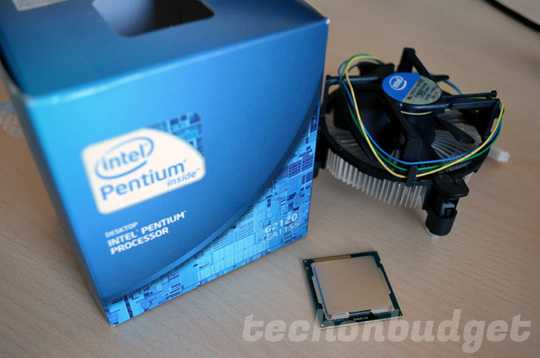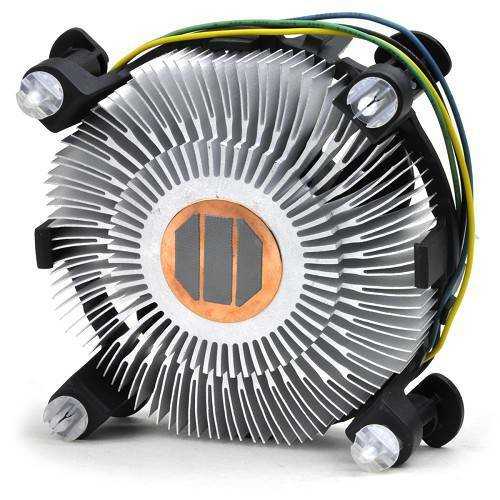0
I bought an Intel Pentium processor (G2120) fan. I could not find any aluminium part under it, and the shopkeeper said that this would be the new model from Intel and I would not need any thermal paste.
Is this true?

0
I bought an Intel Pentium processor (G2120) fan. I could not find any aluminium part under it, and the shopkeeper said that this would be the new model from Intel and I would not need any thermal paste.
Is this true?

6
The comment thread on the question has me horrified.Outside the fan, there's no magnets involved, and the question is phrased such that it sounds like the OP is trying to stick a fan directly onto a heat sink, with heat sink compound.
You generally wouldn't be able to buy a regular 'stock' intel heat sink/fan assembly (HSF) seperately as far as I know. They're aluminum on the outside, have a copper 'slug' for a core, and come with an approved heat sink compound pre-applied
In fact, the business end of the heatsink should look just like this. You line up those pins, gently push them in, and you're in business. Assuming its a heat sink for the right socket type - the fastener locations may vary between sockets

That grey rectangle and trapeziums? Heat sink paste. If its bare metal, you'll need to add some. This is a LGA 1150 heatsink I think, but the same basic bimetallic design has been used since late model PIVs. Older ones were a solid chunk of aluminium, and I believe they had pre-applied heat sink compound
If you think there's magnets on your heat sink... you're better off getting someone who knows what he's doing to install the HSF
2
See the Intel reference guide. This describes everything about the mounting and thermal stuff (you could almost manufacture it yourself from these specs). Section 9.6 (page 88 of 132) describes the thermal interface material and specifies Dow Corning TC-1996. You will need 0.14 grams of it, placed in a 20 mm diameter. The guide has diagrams that show you where to place it to the 0.1 mm. So the answer is yes, you need thermal paste.
Edit: If the unit looks like the picture in Journeyman Geek's post, the thermal paste is already there and you would not need to add more.
Can you identify the fan? It would be hard for someone to determine the answer without knowing what the part is. You wouldn't use thermal paste between a CPU and a fan (unless the fan had an integrated heat sink), but typically, the fan attaches to a heat sink and there is thermal paste between the heat sink and the CPU. – fixer1234 – 2014-11-07T08:00:46.697
Do you have a part number for the fan? Is it simply a miniature fan, like the chassis fan but smaller? How does it fasten? Are you sure that it is not intended to be attached to a heat sink (replacement fan component)? If it is a simple frame with a fan inside, there would be nothing to put thermal paste on. Typically, if a CPU needs a fan, there is also a heat sink (not necessarily sold with the fan, you could just be replacing the fan on an existing heat sink). – fixer1234 – 2014-11-07T08:33:33.007
I don't think the fan is separate from the heatsink here - it's always called a HSF. If you can't boot, the processor is overheating. There may be a bad connection between the chip and the heatsink. This is remedied by a thin layer of paste to allow heat transfer where there may be imperfections. So a fan doesn't need paste, but a heatsink does. Or it needs to be liquid cooled. Can you post a picture of what you're talking about?
– Raystafarian – 2014-11-07T09:54:09.930open tat link. The image inside it is my exact fan which i bought. But the old fan which was defaultly there in cpu was little heavier than this and for old fan we need a thermal paste – Rohith – 2014-11-07T10:25:47.617
The fan in the picture includes a heat sink. The fan removes heat from the heat sink, but the heat sink needs to transfer heat from the CPU to serve a purpose. That requires thermal paste. I assume that the underside of the fins contains a flat surface that would be in contact with the cpu. That's where the thermal paste would go. – fixer1234 – 2014-11-07T18:48:12.773
are you sure that it requires a thermal paste? and it ll get any prob if i apply thermal paste to this model fan, because they said for this thermal paste necessary and under the fan it ll look like small circle which will be like sliver coated and in middle of tat two black rectangle shaped something ll be attached. I think tat is magnet – Rohith – 2014-11-08T03:08:23.047